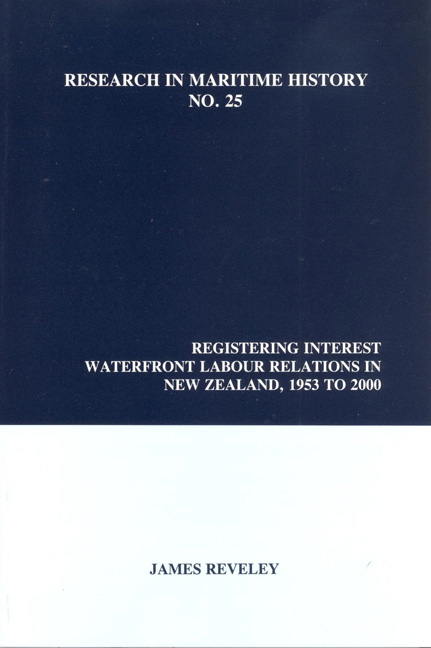Book contents
- Frontmatter
- Contents
- About the Author
- List of Figures
- List of Tables
- Acknowledgments
- Introduction
- Chapter 1 Unions and the Bureau System
- Chapter 2 The Waterfront Employers: Companies and Coordination Mechanisms
- Chapter 3 Labour Relations in the Conventional Cargo Era
- Chapter 4 Negotiating Technological Change
- Chapter 5 Labour Relations after Containerisation
- Chapter 6 Waterfront Labour Reform
- Conclusion
Chapter 4 - Negotiating Technological Change
- Frontmatter
- Contents
- About the Author
- List of Figures
- List of Tables
- Acknowledgments
- Introduction
- Chapter 1 Unions and the Bureau System
- Chapter 2 The Waterfront Employers: Companies and Coordination Mechanisms
- Chapter 3 Labour Relations in the Conventional Cargo Era
- Chapter 4 Negotiating Technological Change
- Chapter 5 Labour Relations after Containerisation
- Chapter 6 Waterfront Labour Reform
- Conclusion
Summary
In 1960 the port union journal Quayside heralded the arrival of a “New Era on the Waterfront.” The author was writing about the introduction of new technology onto New Zealand's wharves. Vehicles such as bulldozers and forklifts, along with material-handling equipment like conveyors, became increasingly common at ports in the late 1950s. These machines affected a relatively small proportion of watersiders’ work - primarily the stevedoring of bulk and palletised cargoes. Nonetheless, this chapter begins by looking at this early round of technological change because it foreshadowed the socially and institutionally contingent effects of containers on waterfront labour markets, employment and work. While labour-process scholars regard container technology as automatically and unambiguously deskilling work that eroded union control over the labour market, this chapter is based on the view that technologies can have different effects in different institutional settings. The potential for containerisation to increase employer control of the labour market and work practices, and to generate considerable labour cost savings through workforce reductions, was not fully realised because of the manner in which local institutions mediated its introduction. Unlike the UK where, following the introduction of containers, new ports like Felixstowe developed outside the National Dock Labour Scheme, all New Zealand ports remained within the ambit of the occupational registration scheme administered by the Waterfront Industry Commission (WIC). To the extent that this scheme bolstered the unions in negotiations with waterfront employers, it allowed them to influence the arrangements for the use of new technology.
The Unions’ Reaction to Technical Progress
The espoused view of the two Federations of port unions during the 1950s was that the introduction of new technology would be supported in order to improve the working conditions of watersiders - but only as long as it did not displace labour. As early as 1953 the general secretary of the South Island Federation (SIF), Paddy Weith, commented at a conference that: “[t]he time…[has] arrived when we should take a lead in testing out any mechanical equipment that could be used both on the wharf and also in the ship to lighten the job for our members.”
- Type
- Chapter
- Information
- Registering InterestWaterfront Labour Relations In New Zealand, 1953 To 2000, pp. 85 - 112Publisher: Liverpool University PressPrint publication year: 2003



